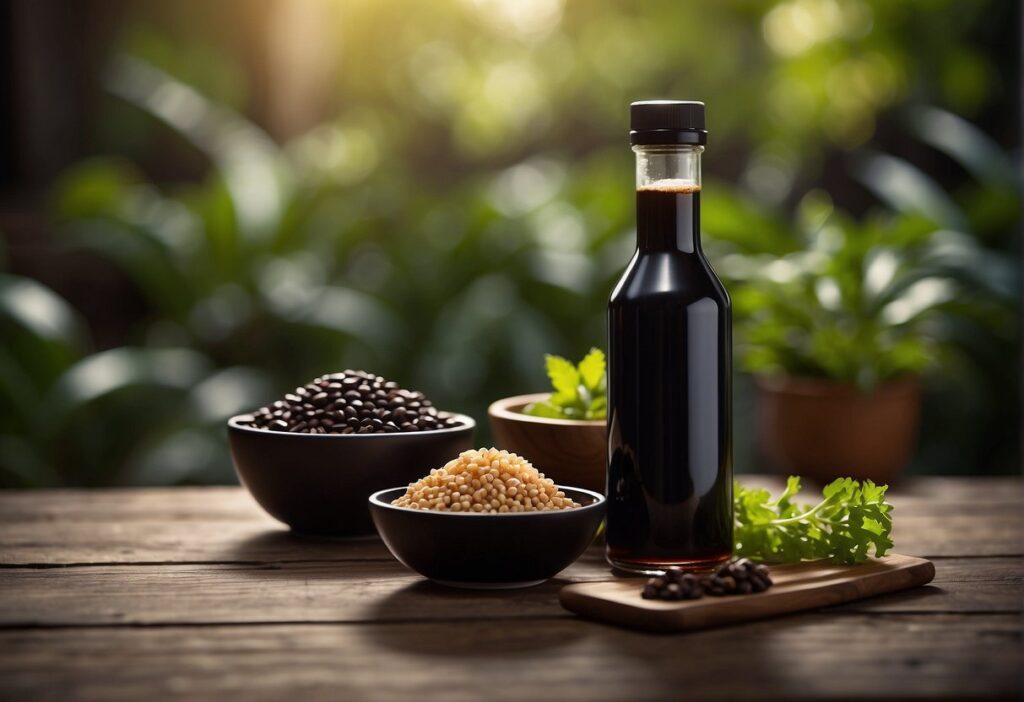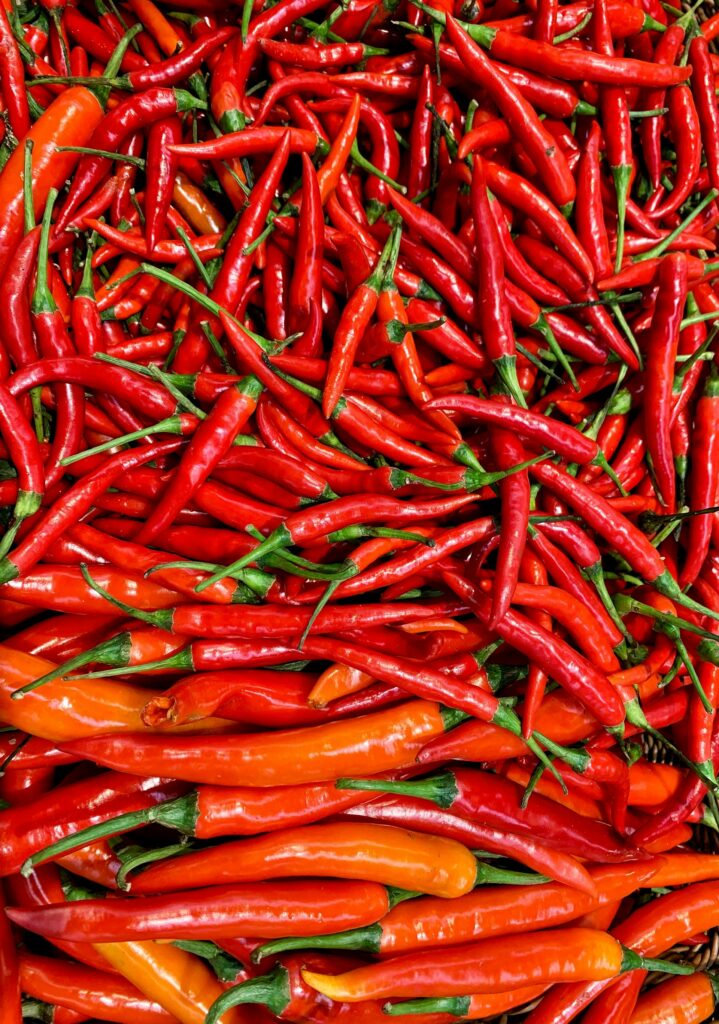
Dark soy sauce is a staple ingredient in many Asian cuisines, treasured for its rich flavor and deep color that enhances a variety of dishes. At times when dark soy sauce is unavailable, cooks seek out suitable alternatives to achieve a similar taste and presentation in their cooking. Understanding the unique characteristics of dark soy sauce is crucial for finding the best substitute.
Finding an appropriate substitute for dark soy sauce involves considering the desired balance of sweetness, saltiness, and umami, as well as the specific role the sauce plays in the culinary creation. Whether it is for marinating, seasoning, or glazing, there are several alternatives, ranging from other types of soy sauces to homemade concoctions, that can provide a comparable depth of color and flavor profile. In the kitchen, experimentation and adjustment can lead to satisfying results even without the original ingredient.
Key Takeaways
- Substitutes for dark soy sauce should mimic its distinct flavor and coloring properties.
- Alternative ingredients can range from other soy sauce varieties to custom homemade blends.
- Adequate substitutes support dark soy sauce’s role in cooking, from seasoning to glazing.
Understanding Dark Soy Sauce

Dark soy sauce is a key ingredient in many Asian dishes, known for its rich color and unique flavor profile. It plays a crucial role in both cooking and seasoning.
Definition and Culinary Uses
Dark soy sauce is a thicker, darker, and slightly sweeter variety of traditional soy sauce originating from Chinese cuisine. It imparts a strong umami flavor and is primarily used for adding color and a rich taste to foods. This sauce is commonly used in braising, stir-frying, and as a marinade to enhance the visual appeal and flavor depth of dishes.
Comparison with Other Soy Sauce Varieties
Compared to light soy sauce, which is more watery and salty, dark soy sauce has a:
- Viscosity: Thicker consistency
- Taste: Sweeter and less salty
- Color: Darker, due to a longer aging process
It should not be confused with light soy sauce, as they serve different purposes in cooking. Dark soy sauce is more suitable for dishes that require extended cooking times or where a deeper color is desired.
The Composition of Dark Soy Sauce
Dark soy sauce is made from fermented soybeans, wheat, water, and salt. The fermentation process is what gives dark soy sauce its distinctive characteristics:
- Sweetness: Comes from the addition of molasses or caramel during production
- Umami Flavor: The result of the natural fermentation process
To encapsulate, dark soy sauce offers both a visual and taste enhancement to dishes, providing a sweet and umami-packed profile crucial for many recipes in Chinese cuisine and beyond.
Common Dark Soy Sauce Substitutes
When seeking a dark soy sauce substitute, it’s essential to match the original’s distinct flavor and color. The following alternatives can provide similar depth and richness to dishes.
Light Soy Sauce and Adjustments
Light soy sauce can be used as a substitute by adding a sweetening agent to mimic dark soy sauce’s molasses-like qualities. Combine 1 tablespoon of light soy sauce with 1 teaspoon of molasses to create a comparable flavor. This mix also has a lower sodium content, which can be desirable for some dietary needs.
Molasses and Soy Sauce Mix
Molasses alone imparts a rich sweetness that resembles the caramel notes of dark soy sauce. Mix 2 teaspoons of molasses with 1 tablespoon of a regular soy sauce to achieve the desired consistency and color. This blend is particularly useful when a thicker texture and a sweeter profile is needed.
Tamari for a Gluten-Free Option
Tamari is a gluten-free alternative that undergoes a similar fermentation process as soy sauce but typically without wheat. It offers a full-bodied taste slightly richer and smoother than dark soy sauce. Tamari works well for those with gluten sensitivities who want to maintain the authentic flavor of their dishes.
Other Savory Alternatives
For those looking for a different twist or with dietary restrictions, several other savory substitutes exist:
- Oyster sauce—thicker with a salty-sweet taste, it can replace dark soy sauce by using a 1:1 ratio in recipes.
- Hoisin sauce—much sweeter, so it should be mixed with soy sauce for balance.
- Worcestershire sauce—contains tamarind and anchovies, adding a distinct flavor similar to dark soy sauce; use in small amounts.
- Coconut aminos—a soy-free, lower-sodium option with a milder flavor, it can be sweetened and thickened as needed.
Creating Homemade Dark Soy Sauce
Making your own dark soy sauce at home allows for customization in flavor and consistency. The process involves combining basic ingredients with some patience, providing a rewarding substitute for the store-bought variety.
Recipe and Ingredients
To create homemade dark soy sauce, you will need the following ingredients:
- Soy Sauce: 1 cup (use a basic soy sauce as the base)
- Brown Sugar: 3 tablespoons (to add sweetness and aid in caramelization)
- Molasses: 2 tablespoons (for color and a hint of bitterness)
- Water: 1/4 cup (to dilute and adjust thickness)
Combine these ingredients in a saucepan over medium heat. Stir until the sugar and molasses have fully dissolved into the soy sauce.
Adjusting Flavors and Consistency
As the mixture simmers, taste it and adjust the following aspects:
Sweetness: If the sauce needs more sweetness, add brown sugar by the teaspoon until desired taste is achieved.
Thickness: For a thicker sauce, allow it to simmer longer or add a cornstarch slurry (1 teaspoon cornstarch mixed with 1 tablespoon water).
Remember, homemade dark soy sauce won’t undergo the fermentation process like traditional soy sauce, and as a result, will be less salty with a gentler flavor profile. Adjust your ingredients based on the flavor you prefer, whether it be more pronounced garlic or ginger notes, or a balance between the savory and sweet components.
Culinary Applications and Pairings
Substitutes for dark soy sauce can be confidently incorporated into a variety of dishes, offering umami depth and savory notes when used as a marinade or condiment. These alternatives adapt well to meat and poultry, enhance seafood and vegetables, and mix seamlessly into noodle and rice combinations, retaining the dish’s intended flavor and color richness.
Meat and Poultry Dishes
Dark Soy Sauce Substitute: Balsamic Vinegar + Sea Salt
- Chicken: A blend of balsamic vinegar and a pinch of sea salt can serve as a marinade to enhance the chicken with a savory richness reminiscent of dark soy sauce.
- Beef: When preparing beef, this same mixture can tenderize and infuse the meat with a complex, sweet yet savory flavor.
- Duck: For dishes like Peking duck, which rely on dark soy sauce, a carefully balanced substitute is necessary to maintain both the dish’s signature glaze and taste.
Seafood and Vegetable Enhancements
Dark Soy Sauce Substitute: Fish Sauce + Sugar Substitute
- Seafood: Fish sauce, when lightly sweetened with a sugar substitute, can offer a similar umami quality to darker soy sauces, elevating the flavor profile of seafood dishes.
- Tofu and Vegetables: Tofu, stir-fried or deep-fried, and vegetables gain depth from this umami-rich concoction, closely mimicking the desired savory notes of dark soy sauce.
Noodles and Rice Combinations
Dark Soy Sauce Substitute: Molasses (Light)
- Noodles: A modest amount of light molasses can impart the requisite caramel color and a touch of sweetness in noodle dishes, replacing dark soy sauce.
- Fried Rice: When adding it to fried rice, the molasses should be used sparingly to avoid overpowering the dish, ideally complementing the existing seasoning without dominating.




